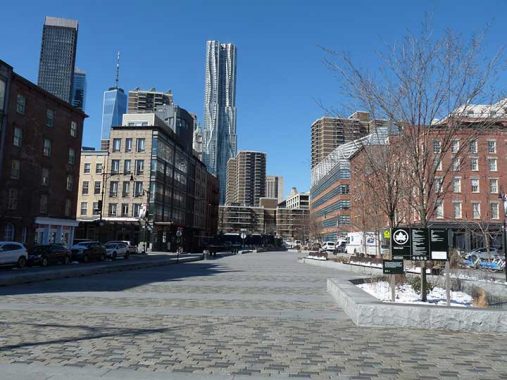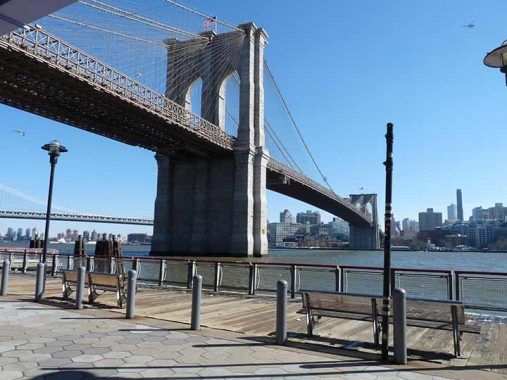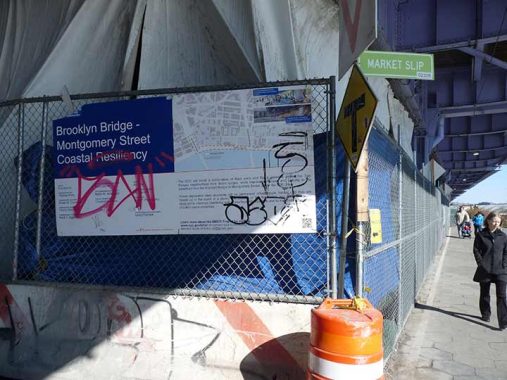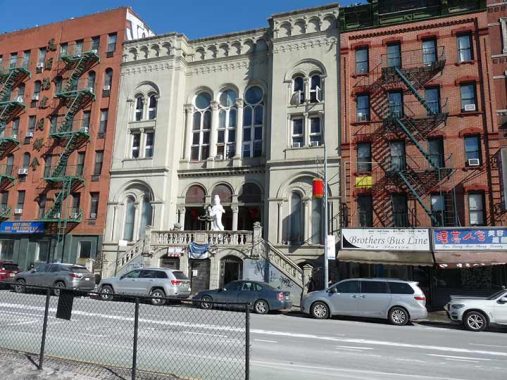
FEBRUARY 18, 2024 was actually looking wintery around town, as we had just wrapped up a couple of snowfalls, rare in NYC winters of late, and it was a sunny, 40-degree afternoon: until June, when the summer heat and humidity set in, sunny Saturdays or Sundays were few, and even rarer in tandem. My plan was to shuffle around the Seaport in lower Manhattan and then take the pedestrian/bicycle path up to 34th Street and catch a bus back to Penn Station. Events have a way of destroying plans, and construction sites under the FDR/East River Drive, where the path is usually open, immediately killed that original idea. Thus, I took a quicker walk north and west and wound up at the Essex Street F train station. Months later, it worked out, as I’m desiring a shorter, photo-heavy page today after a Saturday spent food shopping/walking 3 miles in dead dog humidity and then a Fab Faux concert (thoroughly enjoyed) Saturday evening.

The pedestrianized Fulton Street, the main street of the Seaport, was sparsely patronized in the cold but rest assured, crowds returned by June. Standing out here, on the right, is 19 Fulton Street at Front, newly constructed for the new Fulton Street mall, opening in 1983. It tries to copy the design of the James Bogardus cast iron front building way over on Manhattan’s Lower West Side that now includes Independence Plaza. When blocks of buildings there were razed or relocated in the 1970s and 1980s to make way for the rental towers, The Bogardus Building, designed by the father of cast iron architecture, was dismantled and put in storage to be rebuilt elsewhere. However the dismantled pieces were stolen and never recovered. Hence, the city made a relatively close carbon copy and built it here.

South Street at Fulton is dominated by Schermerhorn Row, which stretches along Fulton all the way to Front Street. The Schermerhorns were a well-established merchant family in NYC in the colonial era. Peter Schermerhorn owned the land here as early as 1792 and began building the Row in 1810, completing it in 1812. It’s been altered considerably over the years; the mansard roof, for example, was added in 1868. Today various restaurants and commercial establishments as well as the Seaport Museum are located in the Row.
If I had taken this picture in 1992 the storefronts would have boasted two old-time Seaport establishments, Sloppy Louie’s and Sweet’s seafood restaurants. Sweet’s, which had been founded in 1842, was lost to a vicious nor’easter in December 1992 and 6 years later, Joe Merino, nephew of original proprietor Louis Merino, closed Sloppy Louie’s. Joseph Mitchell explored the then-mysterious upper floors of the building in 1952; his article published that year in The New Yorker became the subject of a collection of his work, Up in the Old Hotel.
Outside and in, the ancient Tin Building, of course originally used as a fish market, has been reconstructed and revived as a commercial and restaurant hub:
Manhattan’s Tin Building, which has primarily been used as a seafood market, has made several moves during its long life as a commercial building. The Fulton Fishmongers Association first built a wooden market south of the current site along the East River in 1869, then another around the present location near the Brooklyn Bridge in 1894. The current Tin Building was constructed in 1907 and was directly modeled on the 1869 version. In its latest incarnation, it has been reconstructed six feet higher and 32 feet east of that original site.
Time was not exactly kind to the structure. There was a massive fire in 1995, and government refrigeration requirements eventually forced the market to move north to the Bronx in 2005, leaving the Tin Building empty and in shambles. Flooding from Hurricane Sandy in 2012 further damaged the facility. However, after nearly a decade of planning and work, it has been transformed into a high-end destination for dining and drink, as well as a consumer-oriented gourmet seafood and grocery market. At 53,000 square feet, it’s the largest enterprise launched by celebrity chef Jean-Georges Vongerichten. It opened in late September [2022], the product of $194.6 million in investment. [NAIOP]

In one of the great travesties of the modern era, Pier 17, which catered to people with moderate incomes, was demolished in 2018 and a much more ambitious substitute with expensive restaurants and a rooftop arena took its place. The new Pier 17 features “world-class restaurants” and “Concerts on The Rooftop with the best views in the city.”
My contact with this new Pier 17 has been only sporadic. Formerly, the place was what some would call a “tourist trap” with affordable shops, tourist crap, but an eminently affordable food hall on the top floor that was flooded with sunshine. I was a semi-regular at one of the seafood joints, like Mitchell at Sloppy Louie’s, where I could get a pasta tuna salad with french fries for $5.99.
A couple of years ago I blundered into the new Pier 17, stumbled around in the darkened lower floors, walked around inspecting the upscale restaurants I can’t afford; when I made my way to the roof, I was shooed away as a concert was being prepped.
Hardly a Pier 17 of the people any more. Just some people…

One of NYC’s few remaining floating lighthouses, or rather, light ships, the Ambrose LV87 (the nomenclature differentiates it from two other lightships named Ambrose) served the Port of New York, the Coast Guard and Fort Hancock, NJ (as an examination ship) from 1908 to 1966. It was one of three such lightships patrolling the Ambrose Channel, the southern entrance to New York Harbor off New Jersey. Lightships were employed where the seabed was sandy or otherwise inhospitable for construction of a lighthouse, but by the 1960s and 1970s, most lightships had been replaced by automated towers.
In 1968, the Ambrose LV87 was permanently docked at Pier 17 and has served as a floating museum since then. According to “Lighthouses of New York” author Jim Crowley, the Ambrose LV87, in 1921, was the first lightship to use a radio fog beacon. Another lightship, the Frying Pan, is docked at Pier 63 in Chelsea. It was stationed off the coast of North Carolina from 1930 to 1965, and was abandoned and later sunk; it was salvaged in 1989 and took up residence at Pier 63 soon after.
The ship’s namesake, John Ambrose, was honored with a bust that was recently reinstalled in Battery Park.
The Fulton Fish Market, NYC’s primary seafood wholesale market, moved to Hunts Point in the Bronx in 2005, after a tenure here of over 170 years. Old pictures of South Street show sloops, square-riggers, clipper ships and many other classes of vessels docked right next to the street, which formerly abutted the East River. Today, at the Seaport’s Pier 17, you can board sailing ships like the Wavertree (built in 1885) and the lightship Ambrose, and even train for sailing on the Pioneer (1885), Lettie G. Howard (1893) and W.O. Decker (1930).
I was usually in the Seaport area during the day, after the mall along Fulton Street opened in 1983. Fulton Street and Pier 17 catered almost exclusively to the tourist trade, and still does especially in the summer. But before 2005, I could walk around the area during the day and breathe in the heady aroma of raw fish. Overnights, South Street was full of trucks and wholesale merchants, where restaurants and fish markets all over town would come and purchase fish which would be prepared in restaurants and sold to the public. I never witnessed it (for many years, I was working at night myself, uptown) but it was a chaotic, bustling scene, totally New York City in the vibe department. The market is now way up in the Bronx.
The restaurant Fish Market, named for you know what, attempts to reclaim the old market atmosphere. It appears to be a dive bar, but has some Malaysian delicacies on the menu. The awning on South Street used to feature a number of signs of fish wholesalers, and the signage here is clearly imitative. DiFara Pizza is a Seaport branch of the venerable pizzeria at Avenue J and East 15th in Midwood, which some critics say has the best in NYC. I once waited two hours for two slices there on Mermaid Parade Day in June, and other waits have also been lengthy.
The Paris Café occupies the ground floor of a 5-story brick building at 119 South Street and Peck Slip. The handsome structure was built in 1873 and was purchased 10 years later by liquor merchant Henry Mayer and converted to a hotel and a boardinghouse. Some of the frequent guests were inventor Thomas Alva Edison, sharpshooter Annie Oakley, gourmand “Diamond Jim” Brady, and Teddy Roosevelt when he was police commissioner. Meyer opened the Paris Café in 1883 and while the hotel is long gone, the Paris is still going strong. It’s one of the last survivors of the old Seaport restaurant district that formerly boasted Sloppy Louie’s and Carmine’s. I have only been in once, with ForgottenFan Lisa Jarrett, who used to work around the corner at a coffee place on Water Street; regretfully, I did not get any photos, but they are easily found.
I have only been in Paris Cafe that one time, but I can happily say I can go back again because it recently reopened after a period of COVID-era inactivity. Other Seaport restaurants I can recommend are Jeremy’s Ale House, which as where the postgame spread at a FNY Seaport tour has located (during my raging toothache) and the post-Sandy shuttered Bridge Cafe.

Peck Slip, looking west from South Street. The street owes its great width to the fact that it once featured a short canal, or slip, in which boats were docked. The slip was built in 1755 by merchant Benjamin Peck. It was filled in by 1817. Many lower Manhattan streets were once slips in which ships were berthed, and carry the name “slip” to this day.
At the very end of the street, we see #8 Spruce Street, formerly the tallest residential building in NYC, since surpassed. It’s now known as New York By Gehry, after its architect, Frank Gehry; it’s his first major building in NYC after many years. The tower contains only rental units (898 in total), something of a rarity in New York’s Financial District. It contains a public elementary school, which the Department of Education owns, and is made of reinforced concrete. It is 76 stories and 870 feet high.
Unfortunately, Peck Slip used to be a vast plain of Belgian blocks, one of my favorite “plains” of Belgian blocks in the city. However, the city has paved over the center of the slip with asphalt, leaving just thin strips of bricks on both sides, and placed bollards and planters around the central section. This appears to be the prelude to an ambitious plan to position a public park down the center of the slip, but it wouldn’t surprise me if it stays as is for awhile.
The Department of Transportation has always been uncomfortable with traditional Belgian-blocked streets. If you look at the Municipal Archives photos linked above, you notice that a great many more streets used to be block-paved; well into the 1980s I was noticing even main route still had them in spots. However, vehicle axles and bicycles don’t play well with them. In recent months, the city has “tamed” the formerly huge Belgian blocked plaza at Gansevoort Street and 9th Avenue in the Meatpacking but putting elevated curbs around it, and in Brooklyn, DUMBO’s brick streets and exposed former railroad tracks are under fire and some have already been replaced by more “user friendly” pavings.
You don’t see too many of these any more. I’d estimate there are approximately 25 or 30 at the most of these curved-mast octagonal shaft lampposts around town, with and without their thin support brackets. They’re usually found lurking around overpasses, and that’s where we find this one, at the eastern stretch of Robert F. Wagner Senior Place as it meets South Street under the spaghetti ramps that connect the Brooklyn Bridge and the East River Drive, which becomes the Franklin D. Roosevelt Drive further north at Montgomery Street.
These lamps were the first iterations of the octagonal shafts, which were introduced in 1950. After just a few years, they were supplanted by straighter masts without a support bracket. Quite a few of the original 1950s poles are still around…but the curved masts and brackets were replaced with taller cobra neck masts beginning in the 1960s. But when I first started exploring Brooklyn on bus rides at age 5 (with one or both parents, of course) the curved masts were quite common, supporting incandescent SLECO AK-10 “cuplights.”
If you follow Wagner Place (careful, there’s no sidewalk) you’ll also see some of the few remaining cross-shaped “Whitestone” lamps, first used on the Bronx-Whitestone Bridge but then employed on parkways throughout the 1950s and into the 1960s.


I set off on the South Street pedestrian walk, hoping to take in sights similar to these.

However the waterfront path is undergoing some construction to shore it up against flooding. With the ongoing reconstruction of East River Park, which is going to take a long time, I’ll have to revisit this walk in a few years.
I’ll grant the Department of Transportation a kudo for adding street signs that sort-of match the real ones, rendered in Highway Gothic.
I struck off north on Pike Slip (not to be confused with Peck Slip) and Pike Street. The street was named for explorer and War of 1812 hero Zebulon Pike (1779-1813), who led explorations to the northern Midwest and Southwest in land acquired by the Louisiana Purchase, negotiating with Native American tribes and governments and claiming vast stretches of land for the US Government, which was disputed by the tribes. His explorations in the Rocky Mountains led him to the summit in Colorado named for him (though he was unable to scale the peak). Called into duty during the War of 1812, attaining the rank of brigadier general, he was killed by exploding gunpowder that catapulted a rock after a victory over the British at the Battle of York near Toronto.
As Sergey Kadinsky explains in his Allen Street entry, both Pike and Allen Streets acquired a central median and pedestrian mall in 1932. Though Pike and Allen Streets did not flow into each other at Division Street previously, Depression-era traffic engineers were able to connect the two by adding lanes. The widening destroyed a house at #70 Allen where William Bonney, aka Western outlaw Billy The Kid, who began his life of crime in NYC.
As I walked the center mall on Pike, I noted it was the most “schizo” pedestrian malls I ever encountered. Stretches are newly reconstructed and maintained; while other stretches are a cracked, rutted mess. I wonder if the Department of Transportation is reconstructing it piecemeal or is leaving it this way deliberately.

Colorful if slightly disturbing mural on the west side of Pike between Monroe and Madison Streets.

The Sung Tak Buddhist Association at 13 Pike Street was once the Pike Street Synagogue, a Classic Revival building from 1903 that housed the Congregation Sons of Israel Kalwarie, Poland. Entertainer Eddie Cantor was bar mitzvahed here in 1905. The tripartite façade, which has an arched portico reached by twin lateral staircases, reflects Romanesque and classical features.

In its heyday (1880-1942) the Second Avenue El separated from the Third Avenue El at Chatham Square, ran up Division Street for about three blocks, then up Allen Street, 1st Avenue, East 23rd, and 2nd Avenue, rejoining the Third Avenue el for shared trackage over the Harlem River and then splitting apart again in the Bronx.
The 2nd Avenue El was built between 1879 and 1880, a 7.5 mile stretch, in 18 months. It will take most of the 21st Century to complete its replacement line, the Second Avenue Subway, which will be completemore than a century after the el was torn down, if the present rate of construction is not accelerated.
Manhattan Railway Co. Station No. 5 powerhouse, serving the 2nd Avenue el was never razed. The slant on the corner allowed the el to curve onto Allen Street.
A look at the Allen Street median. There are passable and improved sections, but nothing as bad as parts of Pike.
Headed for the train from here, getting my legs back after a lengthy layoff.
As always, “comment…as you see fit.” I earn a small payment when you click on any ad on the site. Take a look at the new JOBS link in the red toolbar at the top of the page on the desktop version, as I also get a small payment when you view a job via that link.
6/23/24


14 comments
I can’t quite articulate why this is so, but somehow having a dismantled building stolen – in two installments, as it were – is one of those things that could only happen to New York.
Once during a bout of insomnia in the ealy ’70s I went downtown and stumbled across
the fish market in full swing.Hustle and bustle.Around dawn everyone started packing it
in and closed up shop for the day.I wonder if the new market is the same way.Maybe we
can get Walsh to go up there and check it out for us sometime.Whaddaya say?
Your photo and mention of Pike Street Synagogue ahows a typical design element. Many such synagogues had a dual exterior stairway leading to the main floor. Was this just to achieve a symmetrical design? I thought maybe the buildings purpose may have required separate entrances for men and women. Thoughts?
Concerning Peck Slip, this wide road was designated as parkland in the early 20th century but never used as such. Its transformation started in 2012, restoring the median space for public use.
In regards to the Seaport, my favorite stores of old times here were Alamo Flags and Sharper Image. One had flags of my birth country, and the other had massage recliners.
The ground-floor space of the Pike St Synagogue building (a couple steps down) used to have one of my favorite Chinatown variety stores. Knock-off Crocs for like $2.00!! (Croc-offs) Lrmgobao toilet paper! That is not a typo. $4 rechargeable LED flashlights! OK, they were fairly shoddy…
Crocs??!!
Yes! Those cloglike shoes made of injection-molded foam! I should have gotten a pair. It would have been a cheap opportunity to see what all the fuss is about.
The ugliest things on planet earth.
Well these Croc-offs were even uglier if you can imagine that. I would only have worn them around the house.
I wish they didn’t demolish and rebuild Pier 17, because I liked it as it was.
Me too! The Swatch store. The Sharper Image where you could check out all the gadgets and try out the massage chairs.
At the risk of redundancy, because Joseph Mitchell’s writings already do receive well-deserved mention, on this page and on other pages of this superb site, everyone please please please read the three Old Mr. Flood stories (in the collection Up in the Old Hotel) – the one that bears that name, and then The Black Clams, and the third one about his birthday party. They are a heart-breakingly evocative view into a vanished world, full of profound musings on everything from mollusks to mortality.
Hate to nitpick but the F train station is Delancey Street. Essex Street is the J, M and Z station.
Whatevs. Picked up the F there.